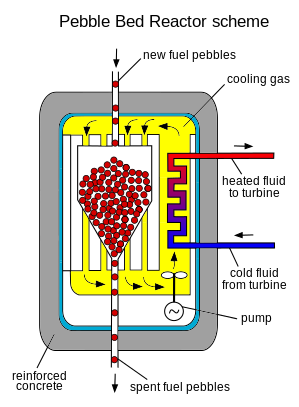Today I am going to discuss the promotion of nuclear power by the United States Department of Energy (USDOE). The U.S. Secretary of Energy Moniz is currently advocating for the use of nuclear power as a clean CO2 free energy source for industrial operations. This suggestion for expansion of nuclear power beyond commerical urban power generation is a welcome boost for the U.S. nuclear industry.
Monitz spoke at the Future of Advanced Nuclear Technologies conference about what are referred to as "fouth generation" nuclear reactors, especially the small modular reactors (SMR), that are currently under development. They are supposed to be simpler, easier to build, safer and even portable alternatives to today's giant power reactors. They are being designed to operate at higher temperature than standard power reactors. Some of the uses being proposed are "process heat, water desalinization, hydrogen production, petroleum production and refining."
The US DOE is in the process of doling out the next portion of its four hundred and fifty two million dollar grant program for the development of SMRs. It is hoped that these SMRs can be built on an assembly line and moved to the location where they will be used. There are several companies competing for the grant money including General Atomics, X-Energy, NuScale and Westinghouse. Many of the proposed designs are supposed to be able to operate between six hundred degrees and nine hundred degrees Celsius, which is much higher than the operating temperature of the current nuclear power reactors. Such high temperature reactors could also generate electricity at a lower cost than conventional reactors.
The Chinese are leading the way in the development of next generation nuclear reactors such as molten salt and pebble bed reactors. They have stated their intention to use such reactors for "hydrogen production, gasifying coal, methanol production and other industrial uses." China hopes to have a two megawatt pilot pebble bed reactor by 2015 and a one hundred megawatt pebble bed reactor by 2024. Considering the agressive Chinese reactor construction program currently underway, it appears that they are not devoting major resources to the new type of reactors or they have not finished research and development of the new designs.
The Obama Administration states that nuclear energy must be part of the mix of new energy sources that are intended to mitigate the climate change being caused by the CO2 being produced by the burning of fossil fuels. The new generation of reactors are also seen as a way to utilize nuclear power while not adding to the risk of the proliferation of nuclear weapons.
While I applaud the desire to find CO2 free sources of energy and to reduce the risk of nuclear proliferation, I am skeptical that the SMRs will be the cheap troublefree energy source that they are claimed to be. It has taken us decades to understand what happens in conventional nuclear reactors. There will be a similar learning curve for the new SMRs. If they are widely deployed before we understand exactly what effect the higher temperatures have on construction materials over a period of decades, it is almost guaranteed that there will be accidents and shutdowns that will make the SMRs much less attractive as a new power source.
